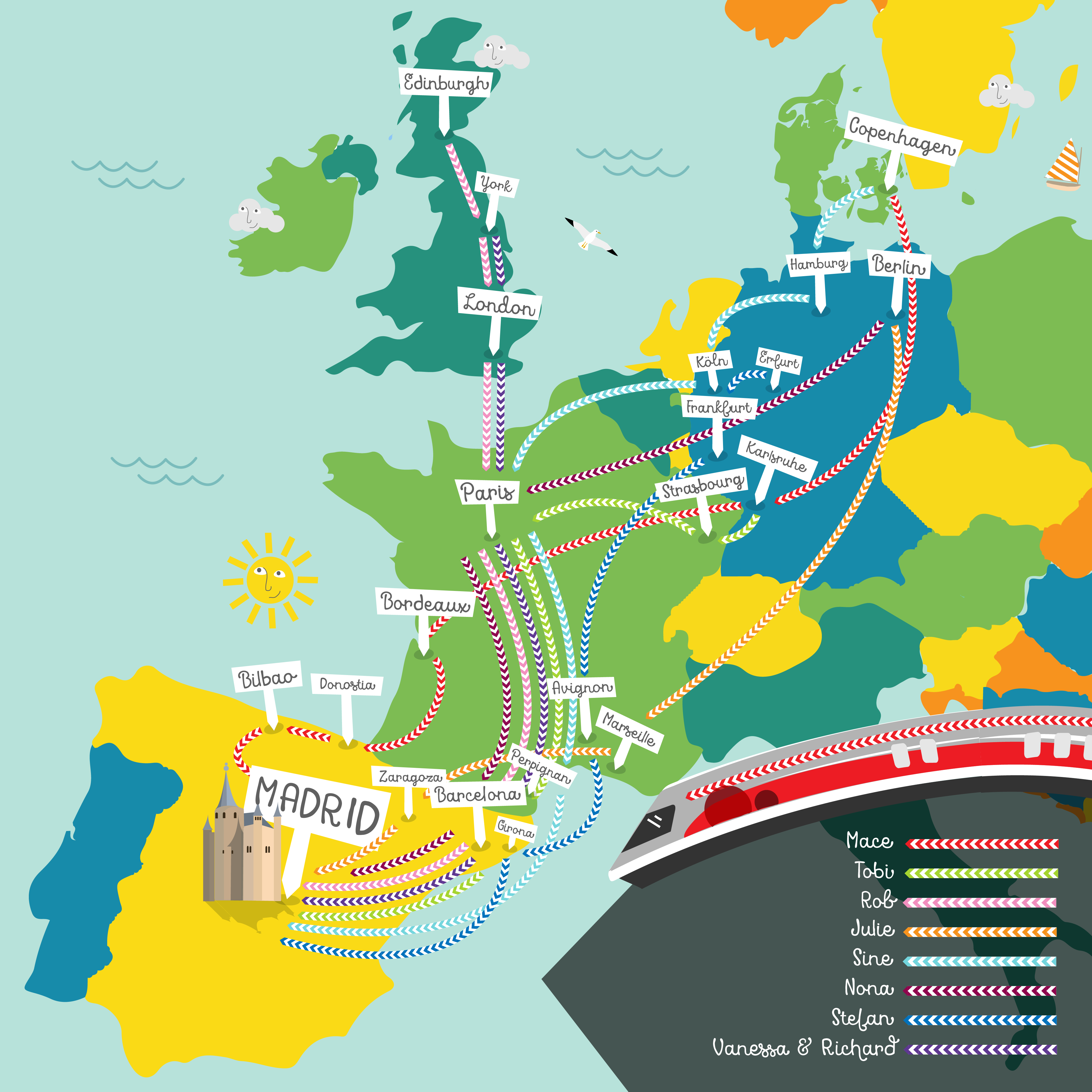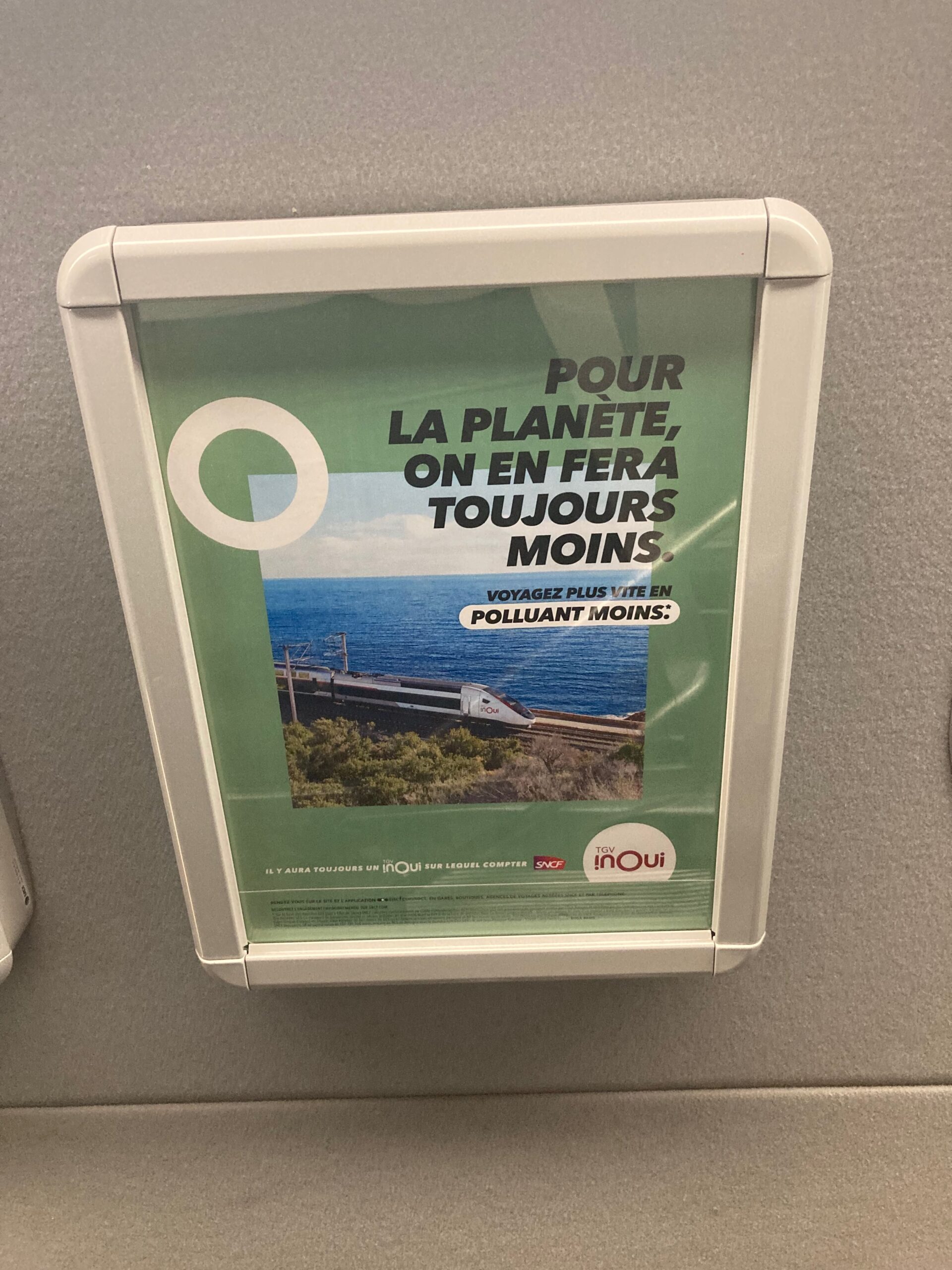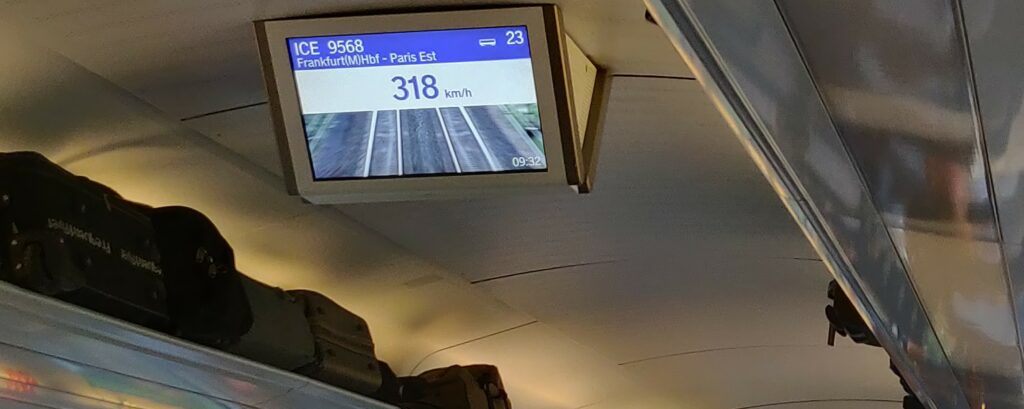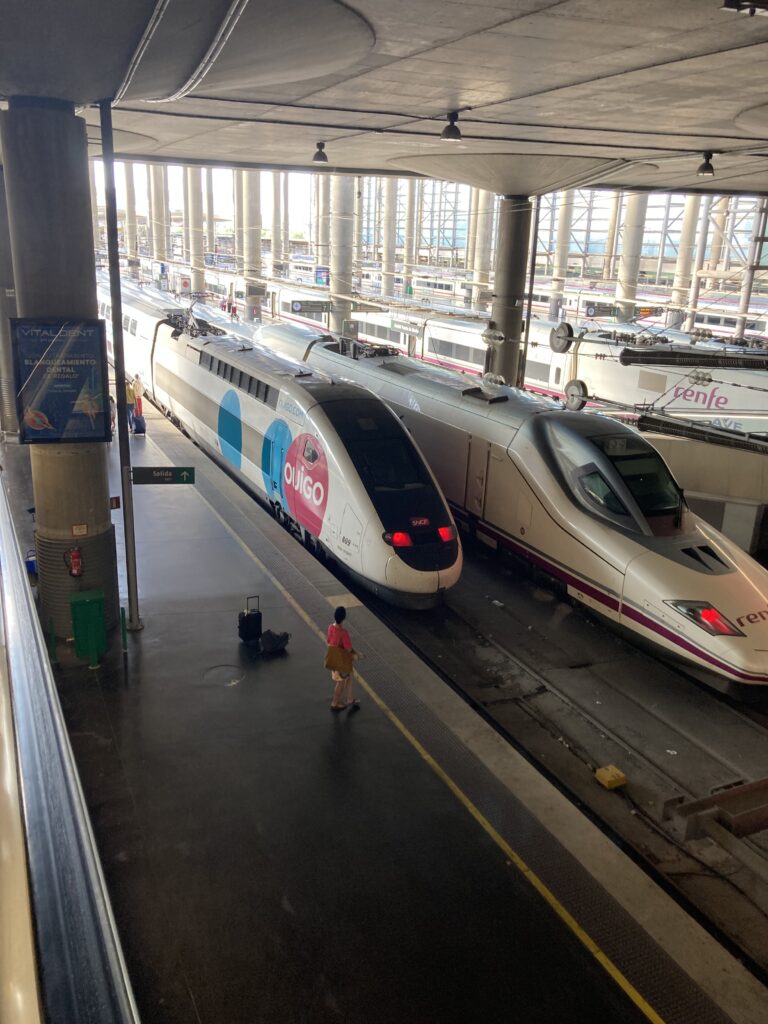The train at platform 22 is for your conference…
Assemblies of STS associations and other academic conferences went online for two years, but with the lifting of public health restrictions, we have seen the return of in-person conferences. Scholars are travelling again. And so the discussion about how to travel has resurfaced, with a focus on carbon emissions and the broader environmental impacts of travel. This also has to do with the experience of digital conferences, which, despite their practical limitations, have indeed facilitated exchange with significantly lower emissions. For example, the European Astronomical Society (Burtscher et al. 2020) estimates that the carbon footprint of its 2020 annual meeting was 3,000 times lower than at previous meetings due to the digital format. So how to learn from this via the railway? The arguments for train transport are straightforward: steel on steel rolls efficiently and can be powered by green electricity; emissions are virtually always lower compared to aeroplanes, cars, buses or ships. The actual numbers are difficult to calculate and vary by route, yet it is a matter of significant orders of magnitude. This is why, for example, the 2022 IPCC Mitigation report (Jaramillo et al. 2022) concludes that rail is an alternative form of transit and can enable decarbonisation, even if a train did not use green electricity or if a carriage only occupied a small proportion of its available seats. Plus, trains offer a more conscious use of space and time and therefore give the opportunity to combine conscious resource use with social concerns, as we will emphasize in this text. As STS scholars, we know that technology use is socially embedded and can take different forms.
Initiatives such as Flying Less and podcasts by the Oxford University Flyingless Group provide information, discussion and practical suggestions on how we as individual academics can alter our practices, but also how to challenge our institutions and professional associations. There are also discussions on how to organise conferences in hybrid or hub-like formats to reduce travel activities. For the recently held EASST 2022 conference in July, some delegates decided to journey by long-distance train across Europe to reach Madrid. As one would expect from a group of STS scholars, this was not done without some appreciation of the sociotechnical challenges involved and of course with that long standing commitment of our field that ‘things could be otherwise’.
In this article, we collect and reflect on the experiences of some of those who travelled this way. We hope others will learn about the pleasures and pitfalls of doing so, and maybe even try it for themselves when we meet in 2024.
Many rails lead to Madrid – How our contributors travelled….
Below you can see the different journeys that contributors took to Madrid for the 2022 EASST Conference.

Why did you choose the train over the plane?
Julie: I prefer to support an infrastructure less harmful to the environment, in alignment with my sense of pace, and much more comfortable in terms of space and air. Besides its comfort, this is a political issue. Employment at academic institutions in the Global North often comes with the privileged position of being able to support alternative modes of CO2-friendlier conferencing. This includes seeking institutional support and using funding infrastructures to avoid flying.
Mace: Environmental concerns of course do matter, but I take the train for æsthetic reasons – airports and all the hassle of getting into and out of, and being funnelled through the travel-industrial “factories” is quite simply insulting to me. I enjoy flying itself, but not the ugliness, anxiety related to security screenings, and the institutionalised pick-pocketing of airports. While I am drawn to liminality, the capitalist realist (Fisher 2009) version offered by the air travel industry is repellant. Instead, travelling by train speaks to my romantic (Kraftwerk 1977; Schütte 2021) and hedonist sides. The train is a convenient, non-exhausting and inspiring choice for a flâneur lifestyle – trains, stations, the views, co-passengers and the infrastructure are interesting and beautiful.
Vanessa and Richard: For various reasons: we wanted to travel in a more environmentally sound way with lower carbon emissions, we wanted a memorable adventure for Vanessa’s first ever STS conference, and we wanted to spend some productive time together to work on our common projects and interests, which we thought the train would afford more easily than travelling by plane. We also wanted to show that it could be done and that we might encourage others to consider travelling this way to conferences and other events as well.
Tobi: Three reasons: A, as the pandemic served as a catalyst for a transition to a more sustainable way of travelling due to cash-stricken airlines, I wanted to pioneer ways of travelling in the field of academia. Conversations with colleagues in my department showed me that time constraint, and a need for convenience, have been bold arguments for preferring the plane over the train. I wished to test an alternative way of travelling that contested both perceived time constraints and a lack of convenience. Also, taking long-distance trains has been a tranquillising, concentration-fostering and socialising activity for many years to me.
Rob: I generally try to choose trains over flying. Obviously, we need to fly less – most people in the world do not fly (Gosling and Humpe 2020) – but it’s also a more humane form of mobility. This time, though, I took the train because my university instigated a ‘Sustainable Travel Policy’. Because my work examines research and funding cultures, often in an interventionist way, I am particularly drawn to the idea of treating this as an experiment that asks what it means to really practice things differently in accelerated academic cultures with a view to reconfiguring them. I wanted to see what it would be like to take at face value the invitation to emit ~85% less carbon on my journey within a web of bureaucracy.
Nona: My decision to take the train was a three-step process involving a sense of adventure and a constant feeling of ‘flight shame’, economic considerations, and social ‘windfall profits’ on the way. For a start, a colleague told me that she would travel to Madrid by train using an interrail ticket. “What a brave and intriguing idea,” I thought, but still hesitated. Then, my adventurous spirit was spurred by the surprising fact that for the first time, it did not cost more to take the train! A four-day interrail pass for Europe (€250) was even cheaper than a reasonable flight route Berlin-Madrid (€550). The decisive moment came when two dear colleagues – one in Barcelona and one in Montpellier – signalled that they would have time to meet me on my passage.
Sine: I am quite afraid of flying. I keep thinking of all the things that can go wrong, and I have a strong irrational feeling that I will die. But I also wanted to see if I could travel more sustainably in the future.
Stefan: When a conference is used to justify flying, we are spinning in circles, with no way off the hamster wheel! But I must add that travelling across Europe is complicated to organise. I also used the conference as a test, proof-of-concept and even for research purposes, because at that time I was employed at the University of Siegen in a research project on rail infrastructure and its role in a potential socio-ecological transition. Travelling with a 3-month-old child added a little extra challenge – reconciling family and career. It works great as long as certain maximum travel times and rest days are respected. The advantage of the car and the plane is that the child can sleep well in peace, but on the train you can get up without danger, keep yourself busy, and even have a snack.


Did you have to overcome any obstacles to travel this way?
Vanessa and Richard: We had to commit more time to attend the conference as travelling by train took longer than flying. We therefore had to spend longer away from our families, but they were supportive of us choosing this mode of transport. Other obstacles we faced arose from not being able to book European continental rail travel through our University’s travel system, so we had to pay upfront and use commercial platforms such as Trainline. The cost of course is also higher than flying, but our Department was very supportive of our approach and agreed to fund our trip without lots of questions.
Nona: Several obstacles … I’ve already mentioned the inevitable four days of travel and sorting out reservations for French and Spanish trains, and choosing the best routes cost me a lot of time (most discounted tickets for interrailers were already sold out. Lesson learnt: Book early!). Another important obstacle was that our panel was scheduled for Saturday and it was clear that I would not make it back to Berlin in time to teach my two courses on Monday. Luckily (or sadly), the pandemic has turned our students into remote learning experts, allowing me to interrupt my journey in the South of France to meet them on Zoom.
Tobi: The most striking obstacle was the actual booking. I had never done such a trip before, so I didn´t know that an interrail ticket was the best choice to travel from Germany to Spain. Firstly, the website of Deutsche Bahn served as the point of departure for booking tickets, but I had no success, so I went in person to the train station in Karlsruhe. The customer service agent there gently asked me whether I was crazy! She could not help with making connections or seat reservations, so I ended up at the interrail website (although I still couldn’t book seat reservations for the Barcelona Sants – Madrid Atocha leg). In my opinion, the booking procedure for international train connections in Europe needs to be as easy as it is for booking a flight.
Rob: Really, the only obstacle was navigating our university travel agent. Our travel policy means that everything has to be booked through the agent and this pushes you towards flights as the form of mobility for international travel. To book things myself through their portal would mean putting together an itinerary on a different website, clicking the ‘flights’ tab of their portal, and then intricately entering each station name of each leg into janky browser boxes in the hope this would find the train. To book things by email required months of exchanges, one of which involved being told that I should fly by Ryanair instead. The other potential obstacle is cost – not of the trains but of the hotels and subsistence that come with adding an extra two nights onto a trip. I was lucky to have a grant that could absorb these.
Mace: I did not encounter any obstacles worth mentioning.
Sine: It was annoying that I had to use several different train apps to arrange the trip, as some of the apps did not recognize the night trains, and with others, I had problems with seat reservations, etc. And the night train I took from Copenhagen to Hamburg was terrible, as there were no sleeping options.
Stefan: There are multiple obstacles: getting our belongings onto trains and moving around with a baby, facing the risk of Covid (although this is also true of flying), finding a website to book the tickets, getting a fair price, and getting the institution to pay for all of this. Let me pick the most important ones from our perspective. Comfort: Not all services make it easy to board with a stroller, stow luggage, and take a seat without any problems. The French TGV stands out as a negative example. We have always managed, but with some effort. TGVs have curved staircases, so sometimes you have to lift heavy things around the corner under time pressure. Sometimes, this even needs help from fellow passengers. Regarding accounting: My institution asked questions about the trip afterwards, and people wondered about the necessity of stopovers. Then I showed them the more «direct» route, which is in fact not that much different than the trip we actually took. Regarding the price, due to the high occupancy of air traffic, the cost of the flight one month before the event would actually have been higher than the cost of our train journey (minus the hotels on the stopovers, which were paid for privately).

How would you sum up the experience?
Vanessa and Richard: It was noticeably less tiring arriving at the conference by train. We also felt mentally better prepared, having spent time working and thinking about the conference on the way there. We felt more aware of our geographical location, the distance we had travelled, and the route we had taken to get there. Eating well was difficult during the long journey – especially if you have specific requirements – and also sometimes the food on the trains ran out!
Julie: The level of comfort of the trains I took from Berlin to Madrid proved to be very high. I had a stable Wi-Fi connection most of the time, and trains were never overcrowded, late, or dirty. Though slightly more expensive than flying, the final difference was less than € 20 between a one-way flight and train ticket to Madrid.
Tobi: In short – rewarding, mentally supporting, geographically enriching. Especially currently, when airports in Europe are struggling with personnel, I surely chose the more relaxing and more comfortable option. The Paris – Barcelona Sants trip was geographically marvellous. Being that close to the Mediterranean is not possible when taking a plane. I definitely will do it again, and I´m looking forward to integrating a sleeper train in the next long-distance train journey.
Mace: I’m quite familiar with city-hopping by train or bicycle across Europe with minimal luggage, and in fact, it’s my favourite pastime. Taking the train to EASST 2022 was rather a familiar than an unfamiliar experience. I will do it again, for work and for pleasure.
Rob: I enjoyed it and would do it again! I wish that universities and conference organisers would actually incentivise it, though. As far as I know, I was the only person from Edinburgh that didn’t fly to Madrid.
Sine: I really liked the experience of meeting so many different people on the way. I talked with a young woman studying programming, a guy working with Google in Zürich, and another one moving from Perpignan to New York. And on the way from Hamburg to Copenhagen, I met another data scientist who was also afraid of flying. Well, knowing statistics does not help against anxiety!

Nona: I very much enjoyed this journey as an infrastructural experience of different sociotechnical mobility systems. The most memorable moment was getting off the train in Cerbère to cross the gap between the incompatible Spanish and French rail tracks by foot. In this place between two systems, I met an exhausted, injured bird in the burning sun on the rail track and we shared a bottle of water before I moved on.
Stefan: This was a splendid experience. I learnt a lot about European cities, modes of transportation, and how climates and landscapes slowly change. Yet I also realized that this is not the standard mode of travelling for business trips of any kind, be it academic or non-academic.
What would be your top tips for anyone thinking of doing the same?
Vanessa and Richard: Take lots of food and drinks and don’t rely on the Wi-Fi. Go with the flow – sometimes trains run late, but the operators will put you on the next one, so best not to be stressed by delays. The good thing is that if you are delayed, you’re more likely to be sat on a train and so can just carry on with what you are doing rather than prowling around a departure lounge! Practically, we also recommend that you use the The Man in Seat 61 website as this provides lots of helpful information about transfer times and hotels to stay at when on route.
Julie: Consider combining conference travels with holidays or attending other events close to the conference venue or on your way. If you are on a budget, book the train tickets and accommodation as early as possible but during the morning or early afternoon on weekdays. Prices tend to go up in the evening and during the weekend. Use night liners for longer distances, and generally avoid rush hours and routes to or from bigger sports/music/whatnot events.
Mace: My number one tip is simply to break up the travel across multiple days. I think the trick is to very concretely materialise to yourself the idea that the journey too matters, not only the destination; if we reject the slave-morality (Nietzsche, 1886) of suffering for the climate and spend some time critically deconstructing the peculiar achievement of air travel as the norm, it takes very little mental gymnastics to experience a train trip as a quest, an adventure … or simply a pleasant day like any other. Reading the Wikipedia articles of the cities you pass through is respectful and educating. Reach out to colleagues, friends and contacts along the way to catch a drink, dinner or a walk with them.
Tobi and Nona: Don´t forget to make seat bookings in advance. Booking seat reservations at a station during the journey may cause trouble and interruptions, at least in France and Spain. Having tasks to do during the journey that do not rely on Wi-Fi is advisable (especially when using German ICE trains). As mentioned earlier, taking the train can be a great pre-conference event. Making a planned journey public on social media, inviting colleagues at the department and beyond, or visiting colleagues on the way will make it even more memorable.
Rob: First, buy interrail tickets! They seem to be cheaper than booking long routes in Europe, even with the reservation fees for TGVs and Eurostar. Second, if you’re taking the Paris metro, have faith that there’ll be another ticket machine if you walk past the horde at that first one. Third: Try to use the cities you go through as an actual opportunity to stop and see your friends, do something work-related or both. Fourth: Take a backpack so you don’t have to drag wheeled suitcases up and down cobbled streets, train steps and escalators.
Sine: Use different apps and try to go for night trains. You might need to find the night train separately by searching for them. For instance, I could have taken a night train (with couchettes!) from Høje Tåstrup to Hamburg, but it did not show up in any of the apps.
Stefan: If you do not fancy planning for half a week, consider using a travel agency that specialises in railways. They know the tricks of the trade to hack the system, and it’s helpful for the accounting apartment to have one coherent bill. In general, I recommend thinking about the possibility of taking a train when travelling with a family. My partner was still on parental leave at the time, and in retrospect, the time we spent together was a socially, economically and ecologically wise investment.


Final reflections
As many of us travelled to Madrid and tweeted photos and updates on our journeys, it became clear that other STS scholars were also on the same rails we rode along, or even on the same train! At that moment, it showed how a conference might begin on the journey there and not only in its formal venue. Had we known, we could have stopped by each other’s seats, caught up over coffee, with the makings of a more humane academic mobile sociality. With this piece, we would also like to encourage you to connect on Twitter next time you travel #flyingless to an STS conference.
Beyond our individual experiences reported here, the STS community needs to engage with how academic conferences are organised in future (e.g. hybrid, or on various continents simultaneously as in the case of this year’s International Sustainability Transition conference). We encourage organising committees of academic conferences and the broader community to advocate for, support and make visible alternative ways of travelling. Many of us travelled to Madrid in an experimental mode or spirit, to test alternative ways of conferencing. Let’s share our experiences and the ‘results’ of this experiment with our institutions.
Useful resources to arrange long distance rail travel in Europe:
The Man in Seat Sixty-One, seat61.com
References
Burtscher, Leonard, Didier Barret, Abhijeet P. Borkar, Victoria Grinberg, Knud Jahnke, Sarah Kendrew, Gina Maffey, and Mark J. McCaughrean. 2020. ‘The Carbon Footprint of Large Astronomy Meetings’. Nature Astronomy 4 (9): 823–25. https://doi.org/10.1038/s41550-020-1207-z.
Fisher, Mark (2009). Capitalism Realism. Is There no Alternative? Zer0 Books.
Gössling, S.; Humpe, A (2020) The global scale, distribution and growth of aviation: Implications for climate change, Global Environmental Change, 65, 102194. https://doi.org/10.1016/j.gloenvcha.2020.102194
Jaramillo, P., S. Kahn Ribeiro, P. Newman, S. Dhar, O.E. Diemuodeke, T. Kajino, D.S. Lee, S.B. Nugroho, X. Ou, A. Hammer Strømman, J. Whitehead, 2022: Transport. In IPCC, 2022: Climate Change 2022: Mitigation of Climate Change. Contribution of Working Group III to the Sixth Assessment Report of the Intergovernmental Panel on Climate Change [P.R. Shukla, J. Skea, R. Slade, A. Al Khourdajie, R. van Diemen, D. McCollum, M. Pathak, S. Some, P. Vyas, R. Fradera, M. Belkacemi, A. Hasija, G. Lisboa, S. Luz, J. Malley, (eds.)]. Cambridge University Press, Cambridge, UK and New York, NY, USA. doi: 10.1017/9781009157926.012
Kraftwerk (1977). Trans-Europe Express. On Trans Europa Express. Kling Klang.
Nietzsche, Friedrich (1886). Beyond Good and Evil: Prelude to a Philosophy of the Future.
Schütte, Uwe (2021). Kraftwerk: Future Music from Germany. Penguin Books.